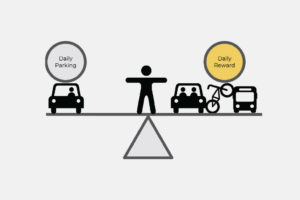BY PAULO NUNES-UENO
Parking is out. Mobility is in.
Strolling the vendor booths at the Canadian Parking Association conference in Toronto this year makes that clear. We are all rebranding, it seems. Including me. The group I started at Seattle’s DOT, called the Transit and Mobility Division, manages transit, bikeshare, carshare, and of course, parking. Now as a consultant, I help clients retool their campus and city parking into ‘mobility’ services.
Mobility. Such a sweet word. If you close your eyes, you can almost hear…the future! Unfortunately, the transportation and ecological challenges we face won’t be solved through slogans. And the stakes couldn’t be higher. Get ‘mobility’ right and we stand a chance against climate change. Getting it wrong also spells extinction for those in the parking–I mean mobility–business.
Technology changes and growth make real adaptations all the more urgent. Re-urbanization is transforming cities throughout North America. Companies that a generation ago would have happily sprawled in suburban office parks are packing into downtown skyscrapers. Witness the new Amazon HQs headed to NYC and Washington DC. We can actually see this change happening inside our workplaces. The typical office from the early 2000’s housed 3 or 4 people per 1000 square feet. Today interior designers and architects with open offices and shared workstation have managed to more than double that.
Too bad transportation can’t claim anything close. None of the innovations to date increase the capacity of roadways or parking lots very much.
Driverless cars, the next big ‘innovation’ afoot, will actually make matters worse. Though we don’t know when autonomous vehicles are coming exactly, we can be sure they will impact the urban landscape. How? Because we have experience with services that drop people off at their destination and keep going. They’re called taxis….
By Chelsea Webster
Let’s start the first mile of this journey by setting a goal for reading this article: learning what first mile and last mile means in relation to transportation, and finding ways for the parking industry to embrace (and maybe even capitalize) on this growing urban challenge.
The Rise of Public Transit
If you live in a city, you likely understand that public transit is an important part of city life. As more of the world’s population moves into cities, and cities aren’t able to accommodate the demand for individual cars and parking, transit will continue to grow in importance. There are lots of articles already touting that the personal vehicle is falling as king of transportation. As this process happens, it will be even more critical to make taking alternate methods of transportation as easy as possible.
If you’ve ever tried to take public transportation, you’re likely aware of a big setback inherent in any transit system: it doesn’t come right to your door.
So, if people aren’t willing to walk to the “nearest” transit stop, but still want to take the train or subway or express bus, how do they get to that transit stop? The process is called first mile (getting from your house or starting point to the transit stop) and last mile (getting from where transit lets you off to your actual destination) commuting.
We Love Our Cars
Thanks to the automobile revolution, we’ve seen the personal vehicle have a massive economic impact. Highways were built, automotive factories churned out vehicles of all sorts, and a whole new parking industry sprang up – all of which created hundreds of thousands of jobs in Canada and the US. With the ability for the average person to own a vehicle, people had the freedom to live and travel to places previously…





